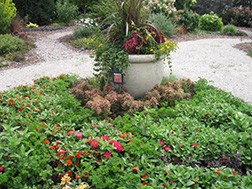Container Gardening: A Lot of Fun In A Small Pot
- Share
- Tweet
- Pin
- Share

Container planters add a variety of color and texture to gardens. Submitted photo.
Wendy Woldt, treasurer of the Door County Master Gardener Association and a frequent speaker on container gardening, says it’s all about trends.
“For the most part,” she says, “if a plant will grow in a garden, it will grow in a container. Edible herbs like rosemary, basil, thyme and sage and ‘fairy gardens’ are popular trends in container gardening right now.”
If you’ve been in a greenhouse recently, you may have seen examples of fairy gardens. Typically, they include fanciful settings for fairies or gnomes (the Internet offers an endless supply of wee furniture, arbors, birdbaths, ponds and fairy pets – even a doghouse and dish for a fairy’s dog). Not all miniature gardens are designed for fairies. Woldt’s, for example, has a farm theme. Dwarf conifers and bonsai trees are also popular for miniature gardens.
Old standbys for container gardening are flowers, grasses and patio tomatoes. Woldt says that the first consideration should be the type of container. Larger ceramic and clay pots can be heavy when filled with soil and plants, so plastic may be a better choice. Many plastic pots available now are attractive and colorful, mimicking more expensive ceramics. Sometimes a container’s design or color may suggest a theme for what it might best be filled with.
For large containers, Woldt suggests a combination of thrillers (tall plants or grasses), fillers (shorter flowers) and spillers (plants that cascade over the sides of the container. She notes that it’s also becoming popular to put just one kind of plant in a container, but to group several pots together – perhaps with a different color in each or a variety of short, medium and tall plants in grouped containers.
Woldt says that container gardening can be seasonal, with bulbs planted in the fall blooming in the spring, replaced with annuals in the summer and mums, flowering kale and grasses in the fall. She also suggests planting perennials in containers. When they die out in the fall, save them to move to the yard the following year as annuals die out.
Also popular for container gardens are hen and chicks, succulents that are members of the extremely hardy sempervivum family that literally means “live forever.” Easy to grow, they thrive in soil where other plants don’t. They need a cold-dormant season to be healthy, and in all but the most severe winter weather, they can survive outside. If some die, replace them with fresh ones.
“It’s fun,” Woldt says, “to revamp, make little changes, fine tune textures and colors.”
For container gardening in shaded areas, Woldt recommends an assortment of hostas that come in dozens of varieties in different colors, heights and textures. For a bright touch, “decorate” pots of hostas with impatiens.
With containers, as with any kind of gardening, watering can be tricky. Woldt says every container must have a hole in the bottom for drainage. If plants seem dry, a tray underneath will help to hold moisture to be absorbed over a period of time.
If they’re getting plenty of water, the excess should be allowed to drain without a tray.
On July 11, Woldt, assisted by Master Gardener vice president Christine Gritzmacher, will present their popular seminar, “Theme-container Gardening on a Shoestring,” at the organization’s annual open house at the Peninsular Agricultural Research Station, two miles north of Sturgeon Bay at 4312 Hwy. 42. The presentation, one of several that day, is free and open to the public.
Among the tips to be suggested is buying containers in the fall or winter, when they’re often on sale. It’s also possible to use containers you already have around the house – milk cartons, trash cans, buckets, crates or wire baskets (the latter lined with sheet plastic or sphagnum moss) – or the ever-popular old work shoes or coffee pots.
Another tip for container gardening on a budget: Learn to over-winter plants indoors and divide them among new pots in the spring.
“There’s so much variety in container gardening, so many new things to try,” Woldt says. “It’s lots of fun.”
There are many sources for additional help and ideas on container gardening.
• Check with a local greenhouse.
• Go online – there are numerous sites with a world of information about planting and tending containers, types of vegetables, herbs and flowers especially suited to container gardening, recommended container size for various plants, soil, fertilizing, watering, light, insects and diseases.
• Look for books like The Encyclopedia of Container Plants and Pots in the Garden: Expert Design & Planting Techniques, both by Ray Rogers, a recent presenter to the Door County Master Gardener Association and the winner of 397 blue ribbons and 88 top awards (including five Best of Show) for container-grown plants at the Philadelphia International Flower Show.
